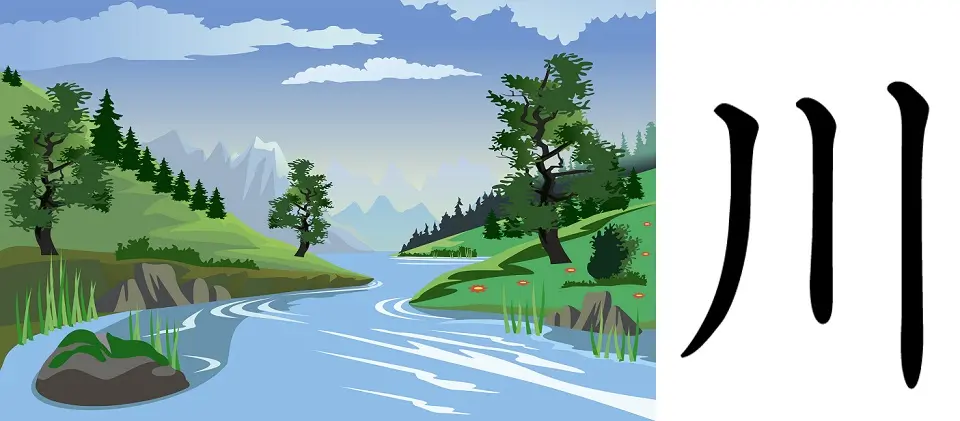Kanji for River: 川 (Kawa)

The Japanese kanji for the river is 川. The Kunyomi or the Japanese pronunciation of the Kanji 川 is “kawa” (かわ), and the Onyomi (Chinese) pronunciation is “sen” (セン).
Please note that though in isolation, 川 is pronounced as “kawa; however, in compound words or names, it can often be pronounced as “gawa.” For example, the word 江戸川, which stands for “Edo River,” is pronounced as Edogawa. This process, where the pronunciation of a kanji changes depending on the context, is known as “rendaku” in Japanese.
The river’s Kanji is constructed with 3 strokes. This Kanji is a part of the JLPT N5 syllabus (please check the list of JLPT N5 Kanji). In Japanese schools, this Kanji is taught in grade 1.
Origin of the Shape 川
Like many other kanji, 川 has its origins in ancient Chinese oracle bone script, dating back to the second millennium BCE. The character was originally a pictogram or an abstract representation of the flow of a river. The three lines, flowing in parallel, depict the course of a river between two banks.
Mnemonic: How to Remember the Kanji for River (川)


In its ancient form, the Kanji representing a river was wavy, closely resembling a stream of flowing water, but it has been simplified over time to the three parallel lines we use today.
The Kanji for the river is one of the simplest ones to remember. To remember this, you can visualize the kanji as a simple aerial view of a river: the top and bottom lines represent the banks, and the center line represents the flowing water.
River (Kawa) Kanji in Compounded Words
The Kanji for the river frequently appears in compounded Japanese words’ kanjis. There are 87 Japanese words that begin with the Kanji 川, and it appears in 163 words.
Examples of Kanji 川 in Compounded Kanji Characters
Following are the examples where Kanji for river appears in Japanese compounded Kanji characters:
- 川岸 (かわぎし, kawagishi): riverbank
- 川口 (かわぐち, kawaguchi): mouth of a river; a common name for a place
- 川上 (かわかみ, kawakami): upstream; a common surname
- 川下 (かわしも, kawashimo): downstream
- 河川 (かせん, kasen): rivers and streams
- 川柳 (せんりゅう, senryuu): a type of humorous poetry similar to haiku
- 川魚 (かわざかな, kawazakana): freshwater fish
- 川船 (かわぶね, kawabune): riverboat
- 川床 (かわどこ, kawadoko): a type of restaurant with platforms built over a river
- 川縁 (かわべり, kawaberi): river’s edge
- 川幅 (かわはば, kawahaba): River width.
- 川流れ (かわながれ, kawanagare): River current or flow.
- 川沿い (かわぞい, kawazoi): Along the river.
- 川の字 (かわのじ, kawa no ji): People sleeping side by side, resembling the kanji for river (川).
- 川筋 (かわすじ, kawasuji): River course.
- 川原 (かわら, kawara): Riverbed or dry riverbed.
- 川車 (かわぐるま, kawaguruma): Waterwheel placed in a river.
These compounded words demonstrate the integral role of rivers in Japanese culture and daily life.
From the practical aspects of river navigation and fisheries (川船, 川魚) to the aesthetic appreciation of nature’s beauty (川床, 川沿い), the kanji 川 connects with rich meanings.
The Japanese Kanji for river encapsulates the flow of life and nature’s ever-changing yet constant presence, deeply rooted in the Japanese ethos. Whether it’s the poetic expression of 川柳 or the communal arrangement symbolized in 川の字, each term bearing 川 reveals the multifaceted relationship between the Japanese people and their rivers.
Kanji 川 as a Radical and Component in Other Kanji Characters
The Kanji for river 川 is also used as a Kanji radical and component in other Kanji characters. There are two shapes for this radical 川 (kawa) and 巛magekawa・magarigawa). Here, the kanji radical “巛” means curving river.
川 appears in 45 Kanji as a radical or component including Jōyō Kanji.
Examples of 川 and 巛 as Radicals and 川 as Component in Other Kanji Characters
- 釧 (udewa (うでわ) kushiro (くしろ)): Means “bracelet”
- 流 (naga-su (なが-す) naga-reru (なが-れる)): Means “flow”, “stream”
- 訓 (Kun (くん)): Means “instruct”, “precept”, or “Japanese reading of a kanji.”
- 馴 (oshi-e (おし-え) na-rasu (な-らす) na-reru (な-れる) yo-i (よ-い)): Means “get used to”, “tame”
- 梳 (kushi (くし) kushikezu-ru (くしけず-る) su-ku (す-く) to-ku (と-く)): Means “comb”
- 侃 (Kan (かん)): Means “strong personality”, “forthright”, “righteous”, or “kind-hearted.”
- 醯 (su (す)): Means “vinegar”
- 巡 (megu-ru (めぐ-る): Means “go around”, “travel around”, “patrol”)
- 災 (wazawa-i (わざわ-い): Means “misfortune”, “mishap”, or “disaster.”
- 勁 (Kei (けい): Means “strong”, “powerful”, “taut”, “nimble”)
- 逕 (komichi (こみち) or tada-chini (ただ-ちに) or michi (みち): Means “path”, “direct”
- 輕 (karu-i (かる-い), karo-yaka (かろ-やか): Means “light”
- 緇 (kuro (くろ), kuro-i (くろ-い), kuroginu (くろぎぬ), kuro-mu): Means “black”, “blacken”, “black clothes”
Japanese Kanji Combining River and Water
Isn’t it poetic to have words combining the kanji of river and the radical of water? Yes, the Japanese language can also be thought-provoking in this respect. Here are some words where the independent Kanji for the river is compounded with other Kanji characters with the radical of water’s Kanji:
- 河川 (かせん, kasen): “Rivers and Streams” or “River Syestem” in a more formal or technical term.
- 渓川 (けいせん, keisen): Mountain stream; combining 渓 (mountain stream, where 川 is a part of 渓) and 川.
- 河川敷 (かせんしき, kasenshiki): Riverbank; combining 河 (river) and 川 (river) with 敷 (spread out, laying down).
Conclusion: 川 and its Significance
Exploring the kanji 川 for the river in various compound words reveals its deep-seated significance in the Japanese language and culture.
This simple yet evocative Kanji, representing a river, flows through the language, capturing the essence of nature’s presence in everyday life and the historical reliance of Japanese society on its waterways.
From geographical terms like 川岸 (riverbank) and 川口 (river mouth) to cultural expressions such as 川柳 (senryū poetry) and 川床 (riverside dining), each usage of 川 paints a picture of a society intricately connected to its rivers.
Many terms comprising the Kanji of river illustrate how rivers have shaped Japan’s physical landscape and cultural fabric, symbolizing the flow of water and life, tradition, and communal bonds. For example, the following Japanese proverb draws a parallel between the continuous and sometimes unpredictable flow of a river and the journey of life:
川の流れと人生の行方 (Kawa no nagare to jinsei no yukue): “The flow of the river and the course of life.”
Thus, the river’s kanji 川 stands as more than a kanji; it is a testament to the enduring relationship between nature and human civilization, with deep roots in Japan’s rich linguistic heritage.
Do check other Kanji characters on the page “How to Learn and Remember Kanji“.


A long-term ex-pat in Japan, Himanshu comes with an IT background in SAP consulting, IT Business Development, and then running the country operations of an IT consulting multinational. Himanshu is the co-founder and Managing Director of ReachExt K.K. and EJable.com. He is also an Advisory Board Member of a Silicon Valley AI/IoT startup.

